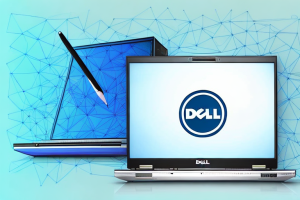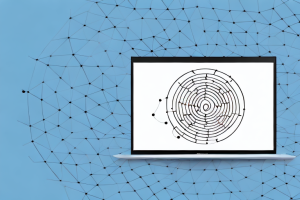How to troubleshoot a Dell Latitude E5570 not charging
9 min read
A dell latitude e5570 laptop connected to a power source
If you’re experiencing issues with your Dell Latitude E5570 not charging, it can be incredibly frustrating. Fortunately, there are several reasons why this might be happening, and a variety of troubleshooting methods you can try to get your device up and running again. In this article, we’ll walk you through the most common issues and solutions, as well as tips for extending the battery life of your Dell Latitude E5570.
Understanding the Dell Latitude E5570 battery charging process
Before we dive into the specific issues, let’s first review how the Dell Latitude E5570 battery charging process works. When you plug your device into a power source, the adapter provides an electrical charge to the battery. The battery then stores that charge until it’s needed, at which point it powers the device. The charging process is managed by the laptop’s charging circuitry, which controls the flow of electricity and ensures that the battery is charged safely and in a timely manner.
It’s important to note that the charging process can be affected by various factors, such as the temperature of the battery and the power source being used. If the battery is too hot or too cold, it may not charge properly. Additionally, using a power source that doesn’t provide enough power can result in a slower charging time or even prevent the battery from charging at all.
To ensure that your Dell Latitude E5570 battery is charging properly, it’s recommended to use the original Dell adapter and to avoid using the laptop while it’s charging. It’s also a good idea to periodically check the battery health using the Dell Power Manager software, which can provide information on the battery’s capacity and overall health.
Common reasons why the Dell Latitude E5570 may not be charging
There are several reasons why your Dell Latitude E5570 may not be charging properly:
- Using the wrong type of adapter or power source
- A damaged or faulty power cable
- A clogged or damaged charging port
- An issue with the battery or charging circuitry
Another common reason why your Dell Latitude E5570 may not be charging is due to overheating. If your laptop gets too hot, it may automatically shut down or stop charging to prevent damage to the battery or other components. Make sure your laptop is placed on a flat, hard surface and that the air vents are not blocked.
In some cases, a software issue may be causing the charging problem. Try updating your laptop’s BIOS and drivers to see if that resolves the issue. You can also try resetting the laptop’s power management settings to default.
Checking the power source: Are you using the right adapter?
If your Dell Latitude E5570 is not charging, the first thing to check is that you’re using the correct adapter and power source. The adapter should be rated for your device’s power requirements, which are listed on the label on the bottom of your laptop. If you’re using the wrong adapter, it may not provide enough power to charge your laptop, or it may overheat and damage your device.
It’s also important to check the power source itself. Make sure the outlet you’re using is functioning properly and providing a steady flow of electricity. If you’re using a power strip or surge protector, try plugging your adapter directly into the wall to see if that solves the issue. Additionally, if you’re using a non-grounded outlet, it may not provide enough power to charge your laptop.
Checking the power cable: Is your cable damaged or faulty?
If your adapter is the correct one for your device, the next thing to check is the power cable. Look for any cuts, kinks, or other physical damage to the cable that could be preventing it from delivering power to your laptop. Additionally, try plugging in the cable to see if it makes a firm connection with the charging port. If the cable is loose or doesn’t fit properly, it may not provide a stable power source.
Another thing to consider when checking your power cable is the length of the cable. If your cable is too short, it may limit your mobility while using your laptop. On the other hand, if your cable is too long, it may become tangled or pose a tripping hazard. Make sure to choose a cable length that suits your needs and workspace.
It’s also important to note that not all power cables are created equal. Some cables may have a higher wattage or voltage output, which can affect the charging speed and overall performance of your laptop. Be sure to check the specifications of your device and choose a power cable that meets those requirements.
Inspecting the charging port: Is there any debris or dirt clogging the port?
If the adapter and cable are working properly, the next step is to inspect the charging port on your laptop. Use a flashlight to check for any debris, dirt, or other obstructions that could be blocking the port and preventing your laptop from charging. If you find any obstruction, use a soft cloth or a can of compressed air to clean out the port carefully.
It is important to note that if you are not comfortable cleaning the charging port yourself, it is best to take your laptop to a professional for assistance. Attempting to clean the port improperly could cause further damage to your device.
In addition, if you have been using your laptop for an extended period of time without cleaning the charging port, it is possible that the port may have become damaged or worn out. In this case, it may be necessary to replace the charging port entirely in order to restore proper charging functionality to your device.
Conducting a battery health check on Dell Latitude E5570
If none of the above methods solve your problem, it’s time to check the health of your battery. Your Dell Latitude E5570 has built-in tools that allow you to check the health of your battery and charging circuitry. Go to the “SupportAssist” app from the start menu, then click on the “Hardware Checkup” feature. From there, you should see an option to check the system and view any issues or errors that could be causing the charging problem.
It’s important to note that battery health can deteriorate over time, especially if the laptop is frequently used while plugged in. If you notice that your battery is not holding a charge as long as it used to, or if it’s taking longer to charge, it may be time to replace the battery. You can purchase a replacement battery directly from Dell or from a third-party vendor.
Another factor that can affect battery health is the temperature at which the laptop is used. High temperatures can cause the battery to degrade more quickly, so it’s important to keep your laptop in a cool, well-ventilated area. Additionally, avoid leaving your laptop plugged in for extended periods of time, as this can also contribute to battery degradation.
Using System Diagnostics to identify charging issues
Another useful tool for diagnosing charging issues on your Dell Latitude E5570 is the system diagnostics menu. To access this menu, restart your laptop and press the F12 key when the Dell logo appears. From the menu that appears, select “Diagnostics” and then “System Diagnostics.” This menu will run a series of tests on your laptop’s hardware and provide you with a report of any issues it detects.
The system diagnostics menu is a comprehensive tool that can help you identify not only charging issues, but also other hardware problems that may be affecting your laptop’s performance. It can test your laptop’s memory, hard drive, processor, and other components, and provide you with detailed information about their status.
If the system diagnostics menu detects any issues with your laptop’s charging system, it will provide you with specific error codes and messages that can help you troubleshoot the problem. For example, it may indicate that your laptop’s battery is not holding a charge, or that the AC adapter is not providing enough power to charge the battery.
Updating BIOS and drivers for Dell Latitude E5570
If you’re still unable to find a solution to your charging problem, it may be time to update your BIOS (firmware) and drivers. Go to the Dell website and enter your laptop’s service tag to find the appropriate downloads for your device. Install any recommended updates and restart your laptop to see if this resolves your issue.
It’s important to note that updating your BIOS and drivers can sometimes be a complex process, and if done incorrectly, can cause serious damage to your device. It’s recommended that you follow the instructions provided by Dell carefully, and if you’re unsure about any step, seek professional help.
Additionally, updating your BIOS and drivers may not always solve your charging problem. If you’ve exhausted all other troubleshooting options and your laptop still won’t charge, it may be a hardware issue that requires repair or replacement. Contact Dell support or a certified technician for further assistance.
How to recalibrate the battery on Dell Latitude E5570
If your laptop’s battery life seems to be fading faster than usual, you can try recalibrating the battery to extend its lifespan. To do this, first fully charge your battery, then unplug your laptop and let it run until it shuts down due to low battery. When this happens, let your device cool down for several hours, then plug it back in and let it charge to full capacity. This process should help your Dell Latitude E5570 remember its maximum charge capacity and provide more accurate readings in the future.
It is important to note that battery recalibration should only be done once every few months, as doing it too frequently can actually harm the battery’s lifespan. Additionally, if your laptop’s battery life continues to deteriorate even after recalibration, it may be time to consider replacing the battery altogether.
Another way to extend the lifespan of your Dell Latitude E5570’s battery is to adjust your power settings. Lowering the screen brightness, turning off Wi-Fi and Bluetooth when not in use, and closing unnecessary programs can all help conserve battery life and reduce the need for frequent recalibration.
Replacing your battery: A step-by-step guide for Dell Latitude E5570
If all else fails, replacing your battery may be the best solution. To do this, first, purchase a replacement battery. Search for the Dell Latitude E5570 service manual on the Dell website. Once you have it, follow the instructions in the manual to safely remove the old battery and install the new one. Be sure to recycle your old battery properly, as lithium-ion batteries can pose a significant environmental hazard.
It is important to note that not all batteries are created equal. When purchasing a replacement battery, make sure it is compatible with your Dell Latitude E5570 model. Using an incompatible battery can cause damage to your device and potentially void any remaining warranty. Additionally, be sure to properly dispose of the old battery. Many electronics stores and recycling centers offer battery recycling programs to ensure safe and environmentally-friendly disposal.
When to seek professional help with a Dell Latitude E5570 not charging issue
If you’re not comfortable troubleshooting or repairing your device on your own, it’s best to seek professional help from a certified technician. A technician can provide a more comprehensive diagnosis of your issue, replace any necessary parts, and ensure that your device is running safely and efficiently.
Conclusion: Tips for prolonging your Dell Latitude E5570 battery life
While troubleshooting your Dell Latitude E5570 not charging issue, remember that prevention is often the best cure. Regularly cleaning your device’s charging port, keeping your BIOS and drivers up to date, and following proper charging procedures (such as fully discharging and recharging your battery periodically) can help extend your device’s battery life and prevent future charging problems.


